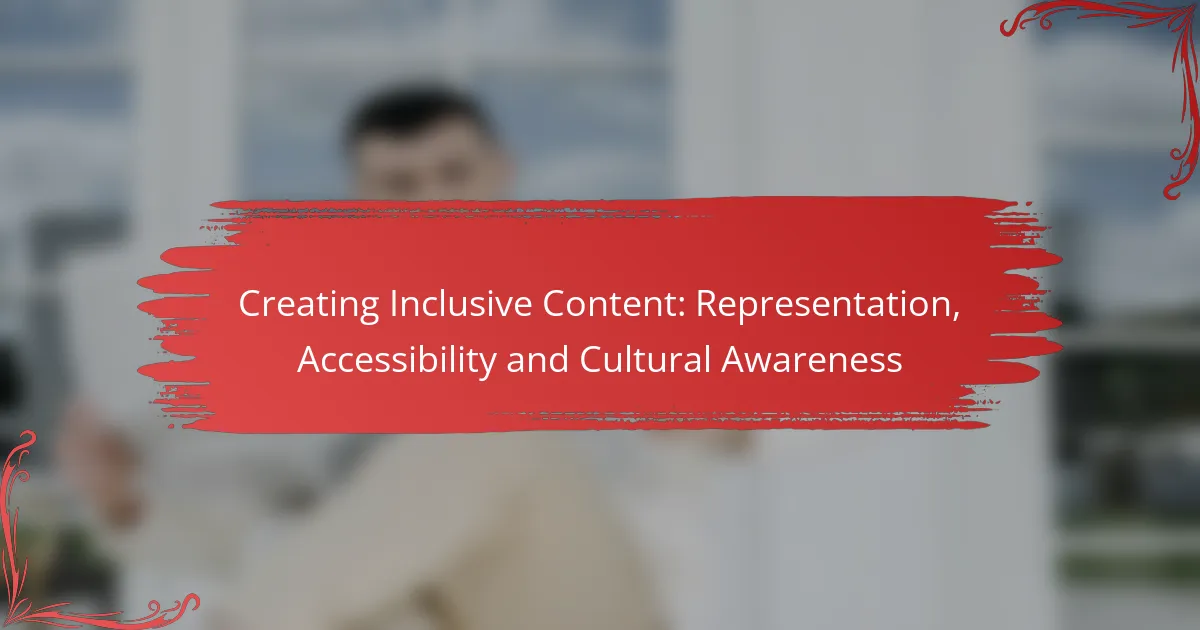Creating inclusive content is essential for reaching diverse audiences and fostering a sense of belonging. By prioritizing representation, accessibility, and cultural awareness, content creators can ensure their material resonates with a wide range of individuals. Implementing best practices for accessibility and understanding cultural nuances enhances engagement and effectiveness, ultimately leading to a more inclusive digital landscape.
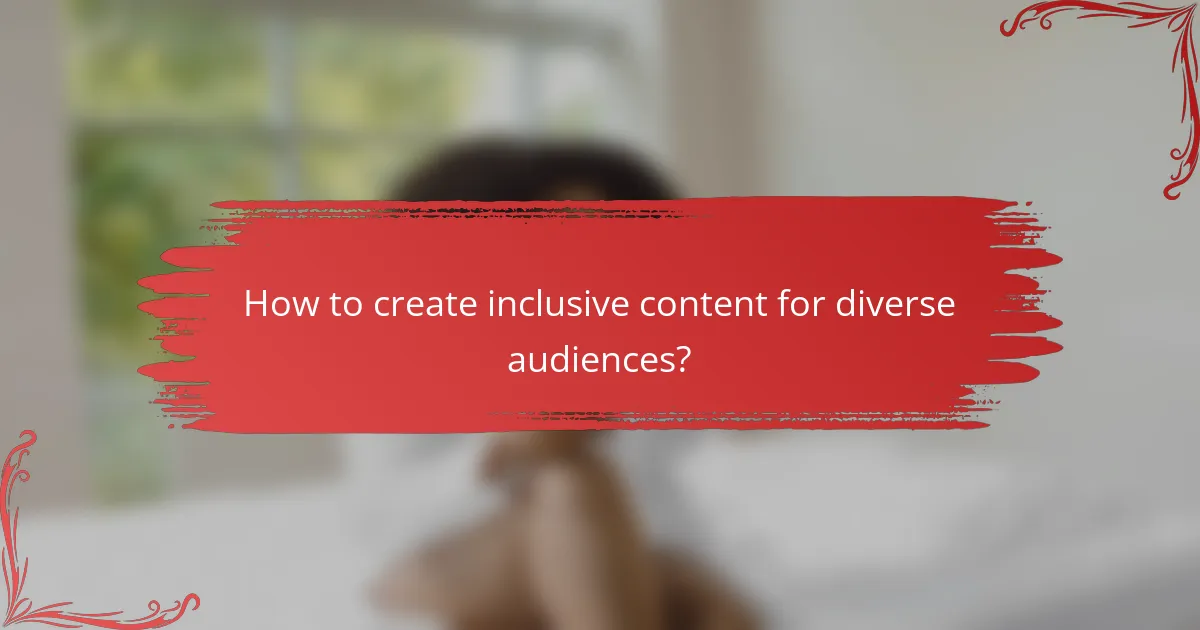
How to create inclusive content for diverse audiences?
Creating inclusive content involves ensuring that your material resonates with a wide range of audiences by considering representation, cultural perspectives, and accessibility. This approach not only broadens your reach but also fosters a sense of belonging among diverse groups.
Utilize diverse representation
Diverse representation means showcasing a variety of identities, backgrounds, and experiences in your content. This can include different ethnicities, genders, ages, and abilities, reflecting the real-world diversity of your audience.
To achieve this, use images, stories, and examples that feature people from various demographics. Avoid stereotypes and ensure that all voices are authentically represented. For instance, if your content includes testimonials, seek out individuals from different cultural backgrounds to share their experiences.
Incorporate various cultural perspectives
Incorporating various cultural perspectives enriches your content and makes it more relatable to a broader audience. This involves understanding and respecting the values, beliefs, and practices of different cultures.
Consider conducting research or collaborating with cultural experts to ensure accuracy and sensitivity. For example, when discussing holidays or traditions, provide context and acknowledge the significance of these practices to the respective communities. This not only educates your audience but also demonstrates respect for diverse cultures.
Ensure accessibility for all users
Ensuring accessibility means making your content usable for individuals with disabilities. This includes adhering to established guidelines, such as the Web Content Accessibility Guidelines (WCAG), which outline best practices for creating accessible digital content.
Use clear language, provide alternative text for images, and ensure that your website is navigable via keyboard. Additionally, consider offering content in multiple formats, such as audio or video with captions, to cater to different needs. Regularly testing your content with users who have disabilities can help identify areas for improvement.
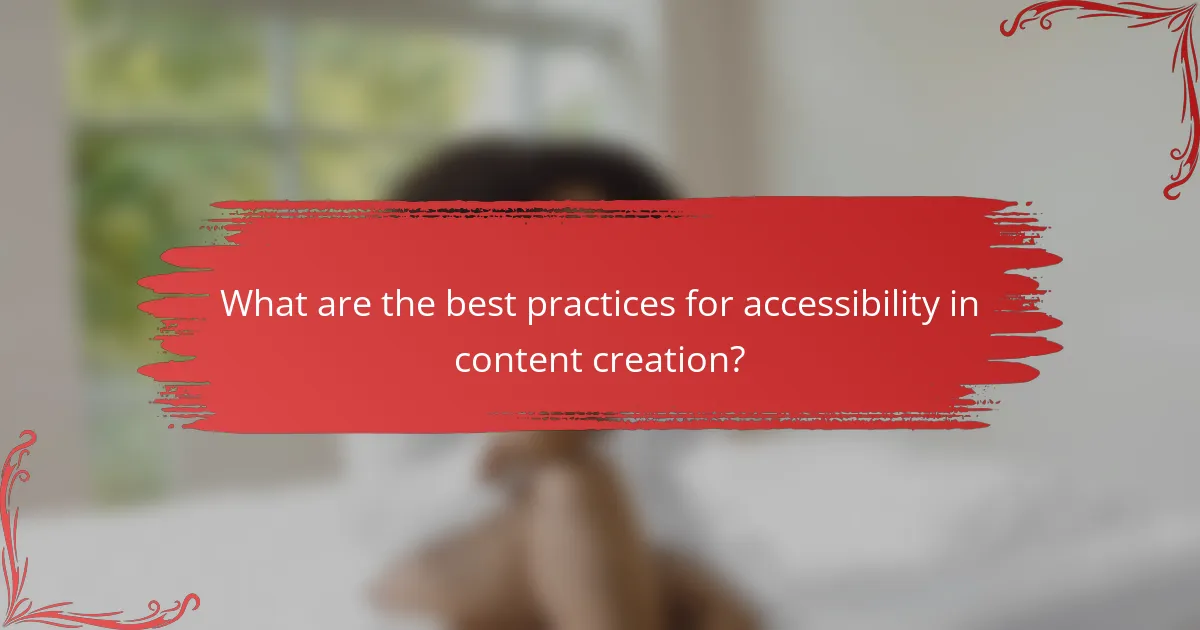
What are the best practices for accessibility in content creation?
Best practices for accessibility in content creation ensure that all users, including those with disabilities, can access and engage with your content. This involves implementing specific strategies that enhance usability and inclusivity across various platforms.
Use alt text for images
Alt text provides a textual description of images, making them accessible to users who rely on screen readers. When writing alt text, be concise and descriptive, focusing on the image’s function or content. For example, instead of “image of a dog,” use “Golden Retriever playing fetch in a park.”
Ensure that all meaningful images include alt text, while decorative images can have empty alt attributes to avoid cluttering the experience. Regularly review your content to confirm that all images have appropriate alt text.
Implement screen reader compatibility
Screen readers convert text into speech, allowing visually impaired users to navigate content. To ensure compatibility, use proper HTML markup, including headings, lists, and tables, which help screen readers interpret the structure of your content. Avoid using images of text, as they cannot be read by screen readers.
Test your content with various screen readers to identify any accessibility issues. Familiarize yourself with ARIA (Accessible Rich Internet Applications) roles and properties to enhance the accessibility of dynamic content.
Choose legible fonts and colors
Select fonts that are easy to read, such as sans-serif fonts, and ensure that text size is adjustable. A minimum font size of 16 pixels is recommended for body text. Maintain high contrast between text and background colors to enhance readability; a contrast ratio of at least 4.5:1 is ideal.
Avoid using color alone to convey information, as this can exclude color-blind users. Instead, incorporate text labels or patterns alongside color coding to ensure clarity for all users.
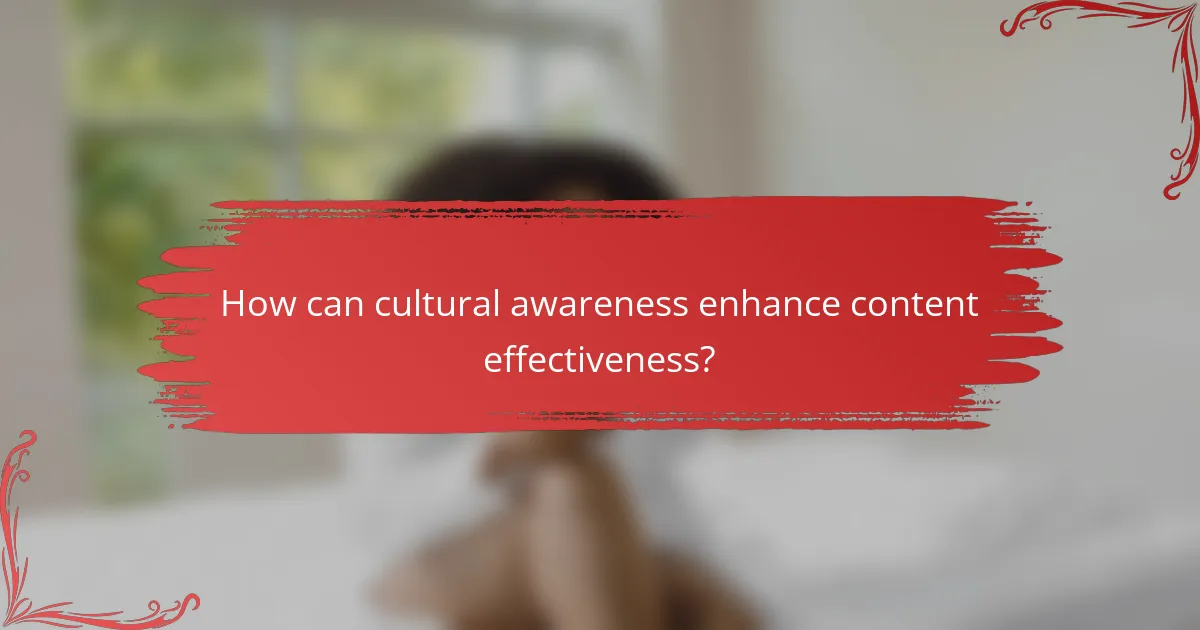
How can cultural awareness enhance content effectiveness?
Cultural awareness can significantly improve content effectiveness by ensuring that it resonates with diverse audiences. By understanding cultural nuances, creators can craft messages that are relevant, respectful, and engaging, leading to better audience connection and response.
Research cultural contexts
Understanding cultural contexts is crucial for creating content that speaks to specific audiences. This involves studying the values, beliefs, and practices of different cultures to avoid misinterpretations or offensive content. For example, colors may have different meanings in various cultures, so it’s essential to research these implications before using them in branding or design.
Utilizing resources such as academic articles, cultural studies, and local experts can provide insights into these contexts. Engaging with diverse sources ensures a well-rounded understanding that can inform content strategy effectively.
Engage with community feedback
Community feedback is invaluable for gauging the effectiveness of content within specific cultural groups. Actively seeking input from target audiences can reveal their preferences and sensitivities, allowing for adjustments that enhance relatability. Surveys, focus groups, and social media interactions are effective ways to gather this feedback.
Incorporating feedback loops into the content creation process helps ensure that the final product aligns with audience expectations. Regularly revisiting community insights can also keep content relevant over time.
Highlight local customs and traditions
Incorporating local customs and traditions into content can foster a deeper connection with the audience. This could involve celebrating local holidays, referencing traditional practices, or showcasing regional dialects. Such elements not only enrich the content but also demonstrate respect and appreciation for the culture.
For instance, a marketing campaign that aligns with local festivals can enhance engagement and show that the brand values its audience’s heritage. However, it’s important to approach these topics with authenticity and sensitivity to avoid cultural appropriation.

What tools can assist in creating inclusive content?
Several tools can help in creating inclusive content by ensuring accessibility, promoting representation, and supporting multilingual communication. Utilizing these tools can enhance user experience and broaden audience reach.
Use accessibility checkers like WAVE
Accessibility checkers, such as WAVE, evaluate web content for compliance with accessibility standards like WCAG. These tools identify issues such as missing alt text, poor color contrast, and navigational barriers.
When using WAVE, simply enter your webpage URL, and it will generate a report highlighting accessibility errors and suggestions for improvement. Regularly checking your content can help maintain compliance and enhance usability for individuals with disabilities.
Leverage content management systems with inclusivity features
Content management systems (CMS) like WordPress and Drupal often include features that promote inclusivity. These may consist of built-in accessibility tools, customizable templates, and plugins designed to enhance user experience for diverse audiences.
When selecting a CMS, consider those that offer features like keyboard navigation support, screen reader compatibility, and options for text resizing. This can significantly improve accessibility and ensure your content reaches a wider audience.
Employ translation services for multilingual content
Translation services are essential for creating multilingual content that resonates with diverse audiences. Using professional translation services ensures accuracy and cultural relevance, which automated tools may not provide.
When choosing a translation service, look for providers that specialize in localization, adapting content to fit cultural contexts. This can include adjusting idioms, references, and even visual elements to better align with the target audience’s expectations.

What criteria should be considered for inclusive content audits?
Inclusive content audits should focus on representation, accessibility, and engagement metrics to ensure that all audiences are effectively reached and represented. Evaluating these criteria helps identify gaps and opportunities for improvement in content strategies.
Evaluate representation across demographics
Assessing representation involves examining how various demographic groups are portrayed in your content. This includes considering factors such as race, gender, age, ability, and cultural background. Aim for a balanced representation that reflects the diversity of your audience.
To evaluate representation, create a checklist of key demographics relevant to your target audience. Review your content for inclusivity, ensuring that no group is stereotyped or marginalized. For example, if your audience includes people with disabilities, ensure that your visuals and narratives include their perspectives.
Assess accessibility compliance
Accessibility compliance ensures that your content is usable by individuals with disabilities. Familiarize yourself with standards like the Web Content Accessibility Guidelines (WCAG) to identify necessary adjustments. This includes text readability, alt text for images, and keyboard navigation options.
Conduct accessibility testing using tools that simulate various disabilities. Regularly update your content to meet evolving standards and best practices. For instance, ensure that color contrast ratios are sufficient and that multimedia content has captions or transcripts.
Analyze engagement metrics from diverse groups
Analyzing engagement metrics helps you understand how different demographic groups interact with your content. Look for patterns in data such as page views, time spent on pages, and social media shares. This information can highlight which groups are resonating with your content and which are not.
Utilize analytics tools to segment your audience by demographic factors. For example, if you notice lower engagement from a specific age group, consider tailoring your content to better meet their interests and preferences. Regularly review and adjust your strategies based on these insights to foster greater inclusivity.
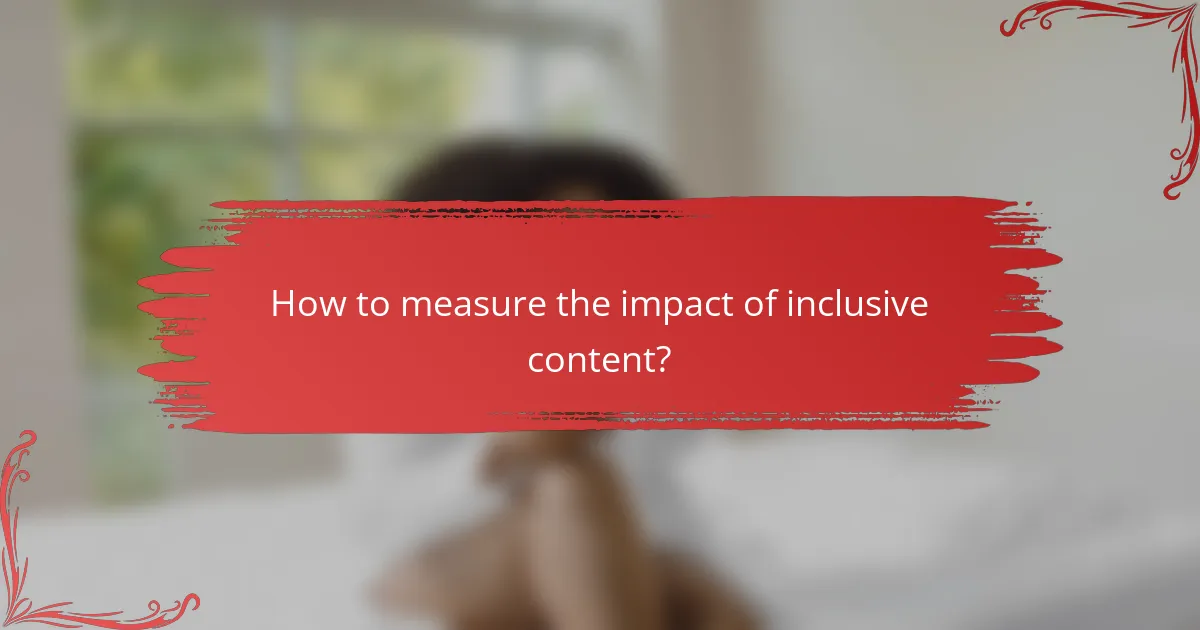
How to measure the impact of inclusive content?
Measuring the impact of inclusive content involves analyzing audience engagement, feedback, and overall reach. By focusing on these metrics, you can assess how well your content resonates with diverse groups and identify areas for improvement.
Track audience engagement rates
Audience engagement rates provide insight into how well your inclusive content is performing. Key metrics include likes, shares, comments, and time spent on page. High engagement often indicates that your content is resonating with your audience.
To track these rates effectively, use analytics tools that can measure interactions across various platforms. Look for trends over time to see if engagement increases after implementing inclusive practices.
Consider segmenting your audience data to understand which demographics engage most with your content. This can help tailor future content to better meet the needs of underrepresented groups.
